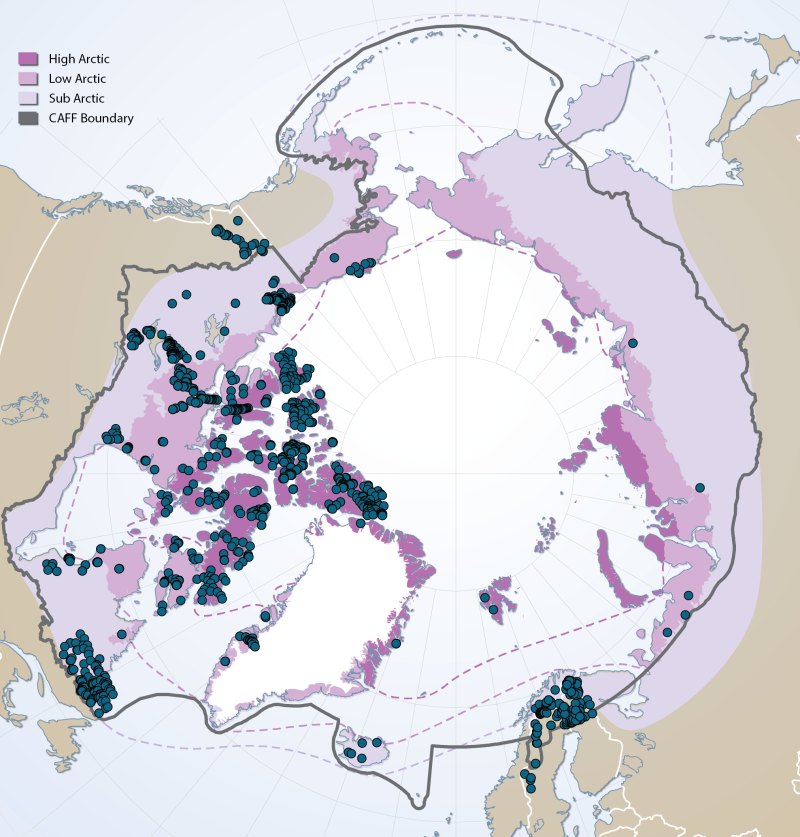freshwater
Type of resources
Available actions
Topics
Keywords
Contact for the resource
Provided by
Years
Formats
Representation types
Update frequencies
status
Service types
-
Description: The Regional Freshwater Index Layers dataset is composed of five single-band raster layers in GeoTIFF format. Each layer corresponds to a marine region, which generally coincide with the following layers from the Species Distribution Modelling Boundaries dataset: Nearshore_HG, Nearshore_NCC, Nearshore_QCS, Nearshore_WCVI, and Shelf_SalishSea. The main purpose of the dataset is to supplement existing layers that are used for species distribution modelling in the Pacific nearshore marine environment. Each regional freshwater index layer has the same spatial resolution and extent as other predictor layers for the corresponding region. While salinity layers exist from oceanographic models, they may not capture local difference from smaller scale rivers and streams entering the marine environment. Therefore, these layers are meant to complement salinity layers and are not suitable as a replacement for salinity data in species modelling. Methods: The cell values represent an estimate of freshwater influence on a 0-1 scale, where a higher value represents a greater level of freshwater influence. Details on how these values are determined is described in the supplemental information section of the metadata. The main data source for these derived products is the B.C. Freshwater Atlas, including the stream network and river polygons layers. Uncertainties: The values in the rasters are not a measure of salinity. The units are an index representing the level of freshwater influence weighted by the stream order and rescaled across regions on a 0-1 scale where only the region with the greatest value has a range of values 0-1 and the other regions are scaled relatively. This is done to ensure that values in one region can be compared to values in another region. As a result, some regions have very small values because the Salish Sea with the Fraser River is dominant, even after applying a rescale factor to the data.
-

This dataset is a generalized view of "Timing Windows for Work in and About Waterbodies in the Cariboo Natural Resource Region" used for viewing the data at the Regional level. Timing windows are the period(s) during the year when work may be carried out in and about water bodies with the lowest risk to fish and wildlife species and habitat. Timing windows and terms and conditions vary based on regional differences in fish and wildlife species and habitat, and geography. The timing window of least risk to fish and fish habitat must be applied to all activities in water bodies, as well as tributaries that have a risk of depositing sediment into water bodies. Windows of least risk are designed to protect all fish species known to occur in a water body.
-

The location of coastal British Columbia marine and freshwater kayaking routes. The Coastal BC datasets are circa 2004 and legacy in nature. Caution should be exercised when using this data, as it may not be accurate or complete. There are currently no plans to update.
-

This file contains a representation of 3rd order watersheds developed for the 1:50,000 BC Watershed Atlas with each watershed polygon coded for occurrence of freshwater fish species (including anadromous salmon in their freshwater stages). The initial fish species codes for presence/absence in each watershed were derived from an GIS overlay of fish species occurrences within broadly defined fish regions for BC. This overlay of fish ranges describes the occurrences of fish species in 30 regions throughout the province. These broad species ranges were derived from McPhail and Carveth's 'Key to Freshwater Fish of BC' and refined further based on the most current expert opinion. Coding for watershed polygons based on this expert opinion was originally: 0= out of species range; 4 = core range; 5= introduced range; 6= peripheral range; 9= estuarine polygons only. A further refinement of watershed fish species coding was developed from actual observations of fish species in the lakes and rivers of British Columbia. This data comes from a number of fish inventory sources. Watersheds with known records of occurrence for each fish species were consequently recoded as such: 4, 5, 6, 9 now equal '1' if a museum record, and, 4, 5, 6, 9 now equal '2' for a less reliable record, and, 0 now equals '8'. for an out-of range record
-

A shapefile of the Nova Scotia Automated Surface Water Quality Monitoring Network monitoring stations. The network was established in 2002 to assess near real-time water quality in surface waters across the province at five river stations and one lake station. The results are used to help manage water resources, determine baseline water quality in lakes and watercourses throughout the province, evaluate the impact of human activities on surface water, and assess long term trends in water quality. The following weblink connects to a Nova Scotia Department of Environment and Climate Change web map that includes the six monitoring station locations and an alternative method for downloading the same dataset: http://nse.maps.arcgis.com/apps/webappviewer/index.html?id=7ded7a30bef44f848e8a4fc8672c89bd
-

List of freshwater fish species recorded from survey data throughout Nova Scotia.
-

Timing windows are the period(s) during the year when work may be carried out in and about water bodies with the lowest risk to fish and wildlife species and habitat. Timing windows and terms and conditions vary based on regional differences in fish and wildlife species and habitat, and geography. The timing window of least risk to fish and fish habitat must be applied to all activities in water bodies, as well as tributaries that have a risk of depositing sediment into water bodies. Windows of least risk are designed to protect all fish species known to occur in a water body.
-
This legacy Web Map Services will no longer be maintained on an ongoing basis as of December 31, 2015. It will be removed from operations as of March 31, 2016. To see the latest in DataBC WMS services please go to http://openmaps.gov.bc.ca.
-

This file contains a generalized representation of watersheds developed from the 1:50,000 BC Watershed Atlas with each region coded for occurrence of freshwater fish species (including anadromous salmon in their freshwater stages). The initial fish species codes for presence/absence in each watershed were derived from an GIS overlay of fish species occurrences within broadly defined fish regions for BC. This overlay of fish ranges describes the occurrences of fish species in 30 regions throughout the province. These broad species ranges were derived from McPhail and Carveth's 'Key to Freshwater Fish of BC' and refined further based on the most current expert opinion. Coding for watershed polygons based on this expert opinion was originally: 0= out of species range; 4 = core range; 5= introduced range; 6= peripheral range; 9= estuarine polygons only. A further refinement of watershed fish species coding was developed from actual observations of fish species in the lakes and rivers of British Columbia. This data comes from a number of fish inventory sources. Watersheds with known records of occurrence for each fish species were consequently recoded as such: 4, 5, 6, 9 now equal '1' if a museum record, and, 4, 5, 6, 9 now equal '2' for a less reliable record, and, 0 now equals '8'. for an out-of range record
-

Sites of existing lake biotic and abiotic data as compiled by the Freshwater Expert Monitoring Group (FEMG) of the Circumpolar Biodiversity Monitoring Group (CBMP) Published in the CBMP Freshwater Brochure 2013 https://oaarchive.arctic-council.org/items/e76cce2c-4c87-4eb4-89d3-c88c3ae955d6
 Arctic SDI catalogue
Arctic SDI catalogue